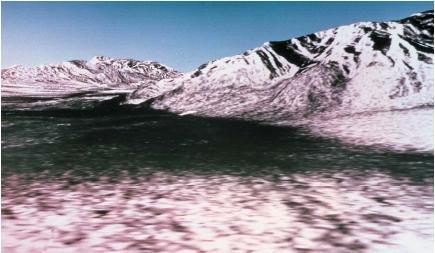Radar
Radar (a contraction of ra dio d etection a nd r anging) is an electronic system that measures the position, speed, or other characteristics of a far-off object by means of radio waves bounced off the surface of that object. It can pierce any atmospheric disturbance, such as a storm, all the way to the horizon. Within its range, radar can reveal clouds, a landmass, or objects such as ships, airplanes, or spacecraft. Radar can measure distance to a target object; for instance, aircraft use it to determine altitude. Radar is also used to monitor atmospheric systems, to track storms, and to help predict the weather. Military applications include weapons ranging (determining the distance from a weapon to a target) and direction in the control of guided missiles.
Basic radar operation
Light waves, radio waves, microwaves, and radar waves are all examples of electromagnetic waves. Unlike water waves, electromagnetic waves do not require a medium such as water or air to travel through. They can travel through a complete vacuum. Similar to light waves, radar waves bounce off some objects and travel through others.
The simplest mode of radar operation is range-finding, or determining how far away an object is. The radar unit sends radar waves out toward the target (radar systems can send out thousands of pulses per second). The waves hit the target and are reflected back. The returning wave is received by the radar unit, and the travel time is registered. According to basic principles of physics, distance is equal to the rate of travel (speed) multiplied by the time of travel. All electromagnetic waves travel at the same speed in a vacuum—the speed of light, which is 186,282 miles (299,727 kilometers) per second. This speed is reduced by a small amount when the waves are traveling through air, but this can be calculated.
Bats and dolphins are able to emit high-frequency sounds and orient (position) themselves by means of reflected sound waves. This ability is known as echolocation.
Radar and World War II
When the 1930s saw the possibility of a German air invasion, the English government accelerated its research into radar. A chain of radar stations was constructed that would throw an invisible net of radio waves over England. These waves could detect the approach and precise location of any aircraft.
When German dictator Adolf Hitler ordered a massive air strike against England in 1940, the radar shield worked. Although the German air force greatly outnumbered the British Royal Air Force, it was soundly beaten because the radar's eye could easily locate German planes, even in darkness and poor weather.
The military use of radar continued throughout World War II (1939–45). Compact transmitters were developed that could be mounted

on the underside of a plane to scan the ground far below for targets. Bombs and shells equipped with radar tracking systems were designed to "look" for their targets, exploding at just the right moment.
Other uses of radar
Radar devices began to trickle into everyday use soon after the end of the war. In 1947, a young engineer named John Barker attempted to use radar to regulate traffic lights. He noticed that a passing automobile would reflect a radio pulse, and that the speed of the vehicle could then be determined by examining the returning signal. Much to the dismay of speeders, Barker had devised the first radar speed-gun, now used by police worldwide.
Marine navigators, surveyors, meteorologists, and astronomers have also found uses for radar technology. A continuous-wave version called Doppler radar is often used to track storms and hurricanes. Probes launched into space have used radar to map the surfaces of other planets.